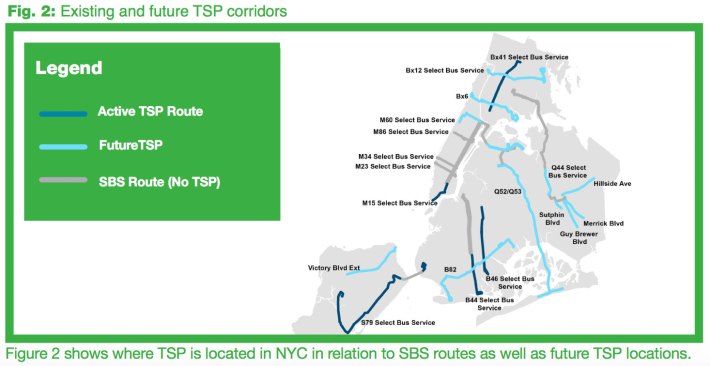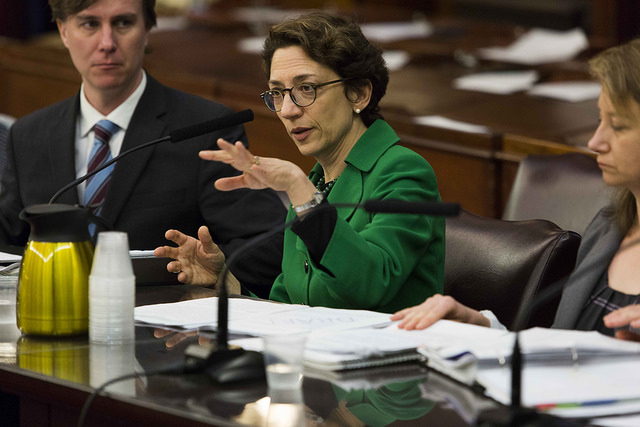One of the big bottlenecks to faster bus service is at NYC DOT, which is slow-rolling implementation of technology that reduces the amount of time buses spend stopped at red lights, known as transit signal priority, or TSP. Yesterday, City Council members pressed DOT to accelerate installation, but Transportation Commissioner Polly Trottenberg said the agency doesn't plan to adjust its current plans.
Transit signal priority relies on technology that enables buses and traffic signals to communicate, so green lights can be held or red lights shortened for approaching buses. The hardware is now ubiquitous, installed on all MTA buses and traffic signals in the city. All that remains is the planning work.
But DOT only intends to implement signal priority on 20 bus routes by the end of 2020. That would leave 92 percent of bus routes without its benefits.
Testifying at the City Council yesterday, Trottenberg said the agency is more focused on intersections as a metric of progress on TSP, not bus routes. DOT will be prioritizing locations "where there's a real bottleneck with buses," she said, with the goal of setting up TSP at 1,000 intersections by 2020.

Even though Mayor de Blasio's draft budget calls for an additional $300,000 to fund DOT planning for transit signal priority, Trottenberg said the additional staff time would not necessarily increase the pace of implementation.
Council Member Mark Levine, whose bill to require TSP on 10 additional routes per year has 30 co-sponsors, wasn't satisfied. “Let’s say there’s 10 people working on TSP," he posited. "If we doubled that wouldn’t we double the number of intersections we can install this on?”
"Not necessarily," Trottenberg said. "We want to see how we can work smarter."
TSP installation involves more than "just flicking a switch," she said. "We understand we need to pick up the pace, but I do want to stress we also want to make sure that we get the engineering right, so that we really actually maximize the improvements in bus reliability and travel times. I don’t want to just do easy intersections where I don’t have to do complicated engineering just to hit the numbers."
But giving buses more green time doesn't have to be that complicated, according to TransitCenter's Jon Orcutt, a former policy director at NYC DOT. He said the agency had wrung more productivity out of its signals team before, and can do it again for transit priority.
He pointed to DOT's success accelerating the rollout of leading pedestrian intervals (LPIs) -- signal changes that give pedestrians a head start at crossings -- as proof. DOT has recently gone from adding dozens of LPIs each year to hundreds. In 2017 alone, DOT implemented LPIs at 832 intersections, an achievement that Trottenberg herself cited in testimony yesterday.
"The city used to go intersection by intersection for that stuff too" before creating rules of thumb that sped up the analysis, said Orcutt. "We think the commissioner needs to tell her own signals guys to get with it on transit priority. Create some templates for those kinds of intersections and get going.”
“Let’s get out there and try something, and stop being so precious about it.”






